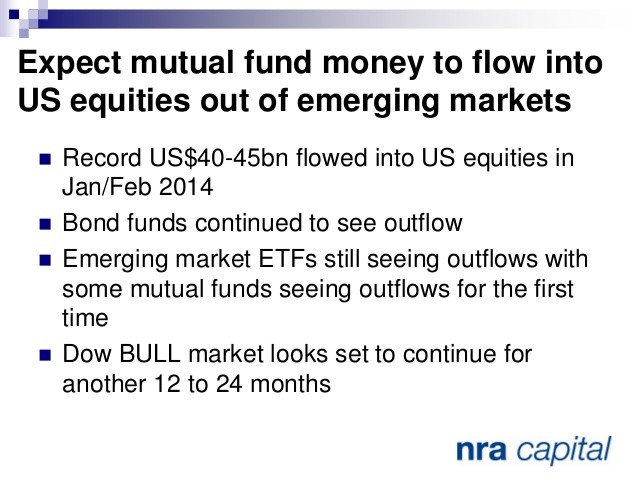Bad Time for Emerging Markets 2014 ETF Outlook
Post on: 8 Май, 2015 No Comment

When Goldman Sachs and J.P. Morgan said to avoid emerging markets in 2014, many investors and market participants thought that the firms were merely sticking to a 2013 trend for too long. Now that call seems to have been full of much more merit. Emerging markets are in the tank, and perhaps not just from the usual source being China.
Chinas poor HSBC purchasing managers report showed contraction for the first month since July. This is on the heels of a 7.7% GDP report in China not being good enough. A few other things are driving emerging lower and lower. Thai riots and election delays are another driving force. Indias woes may have improved but are still present.
Much of the worry continues to be around how a tapering of Fed bond buying will remove the stimulus from the markets. Fears that the bond buying will end in 2014 are weighing on emerging market bonds as well, and the bond markets are perhaps much more important to global economics and currencies than their stock markets. Recent upgrades to global economic growth by the World Bank and International Monetary Fund were also tempered with warnings that emerging markets could remain a serious drag.
Emerging market central banks are almost in a catch-22. If they raise rates to fend off inflation and declines in their currency, they are likely to squeeze credit conditions and limit growth. So the defensive move simply creates the same effect of keeping accommodative policies. And no action lowers their implied credibility. Again, a catch-22.
24/7 Wall St. wants to make a review of the key exchange-traded funds for each of the countries or strategies mentioned. Where this will get interesting is that some of the ETFs under review are getting hurt from dropping local currency fluctuations more than just because of the decline in local the stock markets.
The question is what the outlooks should really be 2014 once things start to normalize. Or maybe, if they start to normalize. The iShares MSCI Emerging Markets (NYSEMKT: EEM) is believed to track the broad emerging markets, although it has much dependence upon China and Southeast Asia. This key ETF was down 2.1% at $38.42, versus a 52-week range of $36.16 to $44.64. The 80 million shares traded before 2:30 p.m. on Friday was already more than 20% above the normal volume.
Is China still an emerging market if it is on track to overtake the U.S. in size within time? That is up for debate, but the drop being seen has reached another point of panic in recent days. The afternoon drop in the iShares China Large-Cap (NYSEMKT: FXI) on Friday was another -1.9% to $34.35 against its 52-week range of $31.35 to $41.93. The average volume of almost 22 million shares was hit before 1:00 p.m. This ETF is down over 10% year to date from the $38.37 close for 2013.
Thailand is now a leader in emerging market uncertainty, particularly with the potential postponement of elections after the major protests that have been taking place. The iShares MSCI Thailand Capped (NYSEMKT: THD) was down only 0.4% on Friday on average volume at $66.47, but the 52-week range is $61.94 to $96.11.
Turkeys lira hit a new low, in what now may be a ten-day trend of that statement. Turkeys woes are possibly more political than economic, but one follows the other in emerging markets. iShares MSCI Turkey (NYSEMKT: TUR) was down 3.5% at $41.42, putting in a 52-week low as the new range for the last year is $41.28 to $77.40.
South Africas rand and Russias ruble also hit multi-year lows. Mining strikes have been back in the news. The iShares MSCI South Africa Index (NYSEMKT: EZA) was down 3.8% at $58.44 late on Friday, with the 52-week range being $53.37 to $69.07. The 426,000 average daily volume was already doubled before 2:00 p.m. on Friday. This ETF hit 150% of the normal 415,000 shares by about 1:45 p.m. on Friday.
Argentina is still trying to fight inflation, and every step that the country takes seems to be the exact opposite of what they should be doing. The Global X FTSE Argentina 20 ETF (NYSEMKT: ARGT) was also down 3.8% at $17.55 against a 52-week range of $15.41 to $21.83. While this trades only 6,000 shares on average, volume was more than triple that shortly after noon on Friday.
Brazil continues to underwhelm against its potential, and social trends in the local economics and politics have turned investors away. When capital is treated poorly in one nation, the capital flows elsewhere. We have just recently written an analysis wondering of the BRIC luster has entire worn off of Brazil. The iShares MSCI Brazil Capped (NYSEMKT: EWZ) was down another 2.3% at $40.24 against a 52-week range of $39.76 to $57.76. The 14 million shares on average had already been met in trading volume by about 1:30 p.m. on Friday.
Mexico has been a market ripe with opportunity again, but the Conference Boards Leading Economic Index just released showed another small decline in November and in October. The iShares MSCI Mexico Capped (NYSEMKT: EWW) was down 1.7% at $62.79 versus a 52-week range of $57.69 to $76.80. This crossed the 3 million share average volume by 2:00 p.m. EST.
Emerging market woes have brought concerns back in India. maybe the concerns never went away, but indian stocks had rebounded handily from the lows of 2013. The drop in the WisdomTree India Earnings (NYSEMKT: EPI) was down 3.3% at $16.46 and the 4.05 million shares on average was already met at 2:00 p.m. Its 52-week range is $12.99 to $20.29.
Before you think of this as a their problem scenario, guess again. Most major industrial companies who sell major goods and services outside of the U.S. and into emerging markets are in the tank too.














